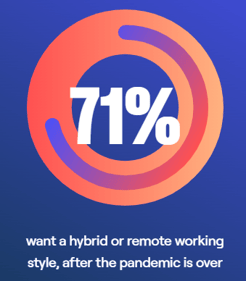 2021 was the year the working world went remote.
2021 was the year the working world went remote.
As pandemic conditions continued to evolve throughout the year, so did the way we work. Employee expectations underwent a seismic shift, with many choosing to opt for more balance and flexibility in where and when they work. With nearly 70% of full-time U.S. workers having worked remotely - and many still doing so - employers have adjusted their workplaces to fit a new hybrid working model.
Shifting Tides
60 Minutes recently featured Chief Economist, Karin Kimbrough of LinkedIn. She pointed out that the data compiled from the website shows that pre-pandemic 1 out of every 67 jobs posted was remote. Today it is 1 in 7. She also noted that today, workers are 2.5x more likely to apply for a job that is remote. If businesses want to attract the best candidates, they need to meet them where they are, which is working from home or a combination of home and office. Right now, employees are defining the rules, not just employers. The pendulum may eventually swing back, but it appears that employees are determined to hold onto their newfound flexibility.
 According to a recent study performed by Owl Labs, 84% of employees shared that working remotely after the pandemic would make them happier, with some even willing to take a pay cut.
According to a recent study performed by Owl Labs, 84% of employees shared that working remotely after the pandemic would make them happier, with some even willing to take a pay cut.
In fact, nearly 1 in 2 people (48%) said that if they were no longer able to work remotely, they would start looking for another job that offered more flexibility in when they worked. In the U.S., 71% of those that worked from home during the pandemic said they want a hybrid or remote working style once the pandemic is over. This shows there is a clear path forward post-pandemic.
Leadership must rethink their workplace culture to be more inclusive of remote and hybrid work - this is the next normal
The global pandemic transformed how we work overnight - and because of this, we’ve officially fast-tracked to the future of work. This shift is comparable to the big digital transformation we saw with the inception of Netflix/Uber, etc. Companies really need to be asking themselves if they are properly prepared for this dynamic shift for the long haul or if they are still working with the band-aid they put on at the start of the pandemic.
Technology holds the key
Many businesses used a quick fix for a remote communication solution when the pandemic hit, thinking it would be a temporary requirement. With the remote workforce taking a permanent hold, do you need to replace the band-aid with a fully optimized solution?
Collaboration has always been at the center of work, but with hybrid workforces, the tools and spaces people collaborate in need to be elevated. To date, only 38% of employers have upgraded their technology to improve hybrid collaboration. There’s still a lot of room for improvement.
In this new era of work, if a company is not using a Unified Communication and Collaboration system, it’s not relevant. It’s really that simple.
It’s clear that seamless connectivity and collaboration are key for those both in and out of the office, which is why employers need to step up and implement hybrid working technologies so that employees can do their best work, wherever they are located.
Consider three requirements when implementing a Unified Communication and Collaboration system that will pair perfectly with this new hybrid work schedule. This new system should be:
- Flexible and elastic – to expand and contract, ebb and flow as your hybrid work model takes shape, then changes, then snaps back, then evolves.
- Capable of keeping business in the middle – so customers can reach you at the same business phone number or email address as before, regardless of where you or your employees are.
- Crazy simple – so it just works, and complexity is a nonissue because you’ll have enough complicated decisions to make about criteria for returning to the office.
The pandemic has proven that anything can happen to disrupt our personal lives and businesses without notice. The good news? We learned a few things in the past two years, and now we can all prepare. We can all set ourselves up for future success.
We’ve had a forced try because of the pandemic, but now is the time to be proactive and strategic with our business decisions and priorities. Implement the right strategies, tools, products, processes, and expectations to navigate any future disruptions. Your employees will thank you for it.
The reality is, most businesses were forced into the remote model and, and are now hybrid to some degree. The most successful companies will be the ones transitioning away from “let’s just survive this crisis” and back toward a long-term strategy. It's time to implement the best practices, tools, products, and processes to permanently transform the modern workplace.




 Unetek
Unetek 